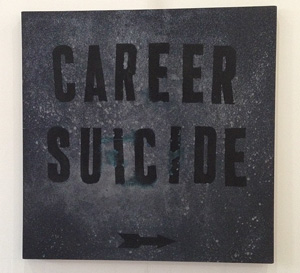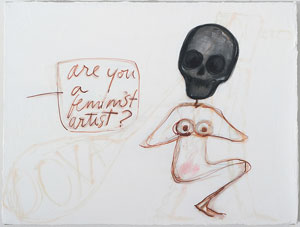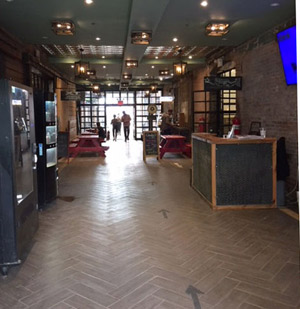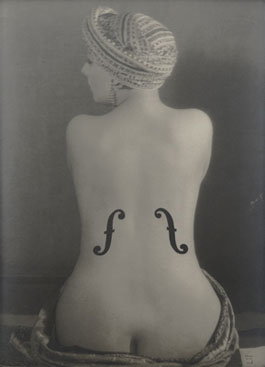The Anti-Frieze
John Haberin New York City
The 2018 New York Art Fairs II
Who would dare to be the anti-Frieze? Plenty, and it could be the new normal for the May New York art fairs.
Not that New York had much need for antifreeze on an unseasonably hot May weekend. (Many a fair a/c could not keep up, and Frieze itself has promised a partial rebate to exhibitors who feel that it discouraged traffic.) But even apart from that, the heat is on. When Frieze moved in from London, it took a slot two months after the March fairs, a site on Randall's Island, and a touch of class to set itself apart. And in no time others moved, too, to catch up. This year, though, the heat is on from both sides. 
Like last year the European Fine Art Fair, or TEFAF, takes the Park Avenue Armory to bask in the high end. Critics complain that too few galleries hog museum-worthy artists—or that too many museum curators cater to big money for their choice of retrospectives. (For the record, I believe that the first is closer to the mark.) So why should they not have a fair to themselves as well? And Art New York still tries to efface its tackier origins. And yet another kind of pressure is bubbling up from below.
You may not have seen it coming. NADA moved back to March this year, with a microcosm of downtown New York. And I reserved my review of Art on Paper then to include with fairs devoted to a single medium—but Moving Image dropped out at the last minute, in search of a new venue. Still, there is no escaping one unending global fair twelve months a year. Emerging dealers may complain that collectors will not head beyond Chelsea, but fairs have popped up in Harlem and parts of Brooklyn out of reach of a subway line from Manhattan. Better yet, a collector, Sylvio Perlstein, aspires to the scope of a fair all by himself, while Frieze, too, rebels against its image.
Remaking the art fair
Frieze insists on having remade itself, and the press ate it up, but is it true? Repeat visitors will recognize the seemingly endless shed, and any large fair has special features. As with many a fair, too, those features keep changing. This year has two sections for single-artist booths—Frame for mostly European dealers and Spotlight for the late twentieth century in New York. That said, pretty much everyone involved is alive. They include Merrill Wagner with Zürcher (her photos as well as abstract paintings) and Mira Schor with Lyles & King (and not just her more obvious imagery of a woman's body).
FYI, curated by Matthew Higgs of White Columns, honors the late Hudson with artists he showed at Feature. See a pattern? Yes, all three sections spotlight younger dealers—and two of three the Lower East Side. Still another feature, Frame, accommodates newcomers as well, while the fair also adds more LA dealers this time out. One last feature, Live, lets in a couple of performance artists, plus a wall painting that Lara Schnitger with Anton Kern dares one to touch. Frieze wants to be relevant and open to America and to you.
Still, the more things change, the more they remain the crazed. Unlike the Armory Show, Frieze does not relegate aspiring artists and dealers to a ghetto. Aisles for more upscale dealers run right through the center of Frame and Spotlight. Frame galleries fall where they may, and still other challengers appear quite apart from special sections—like Koenig & Clinton from Bushwick, Foxy Productions from Chinatown, and Canada from the Lower East Side. At the same time, Frieze can be only so accommodating, and the financial pressures of the art fairs just will not go away. Some in FYI, like indeed Canada, thus get two booths, but they pay the price.
 Big players often settle on solo acts, too. Matthew Brannon with Casey Kaplan evokes a Vietnam War that he is too young to remember, and Robert Therrien with Gagosian goes down the rabbit hole with a preposterously oversized folding table and chairs. David Zwirner has enough money to give Jordan Wolfson and Josh Smith adjacent booths to themselves. Arthur Jafa with Gavin Brown sets images from popular culture in irregular arrays on fields of gray. No longer the agony and pride of black lives alone, as with his video, they still connect the density of a familiar past to the immediacy of the present—like a proper fair.
Big players often settle on solo acts, too. Matthew Brannon with Casey Kaplan evokes a Vietnam War that he is too young to remember, and Robert Therrien with Gagosian goes down the rabbit hole with a preposterously oversized folding table and chairs. David Zwirner has enough money to give Jordan Wolfson and Josh Smith adjacent booths to themselves. Arthur Jafa with Gavin Brown sets images from popular culture in irregular arrays on fields of gray. No longer the agony and pride of black lives alone, as with his video, they still connect the density of a familiar past to the immediacy of the present—like a proper fair.
Speaking of remakes, Art New York changed its name last year for good reason. The former Miami New York does not stand for any one city or the state of the art. It may be on the edge, on the same pier as half the Armory Show—but it is all about giving regional dealers access to the city. Not that the fair can shed its roots. If every large fair resembles a shopping mall (just as every small fair resembles a yard sale), this is the malling of Manhattan. It has the cheapness of a poster shop, although at far higher prices, and a stifling uniformity.
You may recognize names like Frank Stella, George Rickey, Sam Francis, and Mel Bochner, but in prints and the secondary market. You may recognize still more from that period's style in the hands of others, with ever so many large faces, screen prints, and gestures toward abstraction. What you will not find is an older art, younger artists, diversity, or the leading names of today. Booths labeled Context host "emerging, midcareer, and cutting-edge artists by new and established contemporary galleries"—which is to say anything or nothing at all. Special projects appear in common spaces, but they, too, blend in with surrounding galleries. Adrien Brody adds Metamorphosis: Transformations of the Soul, as a cluttered room for his memories, but my soul headed elsewhere.
The heat from below
Closer to the margins, a Noho gallery positions itself for fair week as Salon Zürcher. It invites five galleries from Brussels and Paris alongside Norte Maar, which pushes further and further out in Brooklyn, almost to the point of requiring a runway at Kennedy airport. That gallery excerpts from a larger show of women artists, unfocused but with a fine wall for Hermine Ford, who makes the case for white space and seemingly chance impressions in a self-generating geometry. Galerie Pixi interweaves recent paintings by Duncan Hannah with photos by Alexis Poliakoff, as two attractive visions of a coy sexuality and the 1960s. Feminism after Cindy Sherman may have rendered them irrelevant or embraced them. Susan Shup with Galerie Louis Gendre almost ruins it by quoting "People," as in Barbara Streisand, but then fairs are all about people.
What then about the heat from below? It starts just a few minutes from Chelsea and even closer to the High Line, so you can be sure it is everywhere. Superfine! is back for a second year, with an exclamation point. I must be softening,  but I could hardly resist its flash and trash, from artists and galleries almost anywhere but here. Add an opening-night party starting at nine and such events as wine and art pairings, and who would dream of asking about the paintings? I did not make it to TEFAF to ask, but I did make it to Harlem.
but I could hardly resist its flash and trash, from artists and galleries almost anywhere but here. Add an opening-night party starting at nine and such events as wine and art pairings, and who would dream of asking about the paintings? I did not make it to TEFAF to ask, but I did make it to Harlem.
The first International Independent Art Fair brings thirty artists to Lennox Avenue. For all its title, it is enough of an outsider to lack a Web page apart from Facebook, much less press coverage, galleries, or a noted curator. What it does have is a more than century old church and an African American history. Art makes use of fabric, stones, and a wall crumpling to the floor. Is that silhouette in black a human organ or Africa? Only the striding sculpture facing it, with a debt to late Willem de Kooning, could say for sure.
I never did manage Red Hook for 1-54, a small show of contemporary African art. Yet I did step out of old habits to see if art and collectors would follow. When a fair squeezes into the lobby of a boutique hotel, one can count on two things—a happy hour and decent bathrooms. Otherwise, in its second year at the Nu Hotel after four years of wanderings, Fridge is as uninviting as the rest of downtown Brooklyn. It would take a sharp eye to tell the VIP list from hotel guests. And neither was paying much attention to the cautious and self-curated paintings.
Moniker would have a hard time living up to the building or the bar, but then the bar is art, too. Egle Zvirblyte, a Lithuanian whose "sweet" and "juicy" women greet one at the door, painted it with the same bright colors. A mere thirty artists adopt the many storied Greenpoint Terminal Warehouse, which alone is worth a visit. They earn the label international, but they have a distinctly local flavor—right down to Meres One (aka Jonathan Cohen), whose tags joined in the raucous mess at 5Pointz. That building fell to gentrification across from MoMA PS1, but this one's artist studios and public spaces endure. If you missed the fair, you could always show up for the taco sampling the next week.
Is this corner of the Brooklyn waterfront for locals only? Not so the hundred and thirty faces in the Other Art Fair, in shinier quarters just around the corner. From its sponsor alone, Saatchi, you know that this is art designed to move, from tattoo designs to celebrity faces and abstract noodling. Stephen Cimini enlivens his geometry with marble dust and Zandra Stratford hers with text, but the stately here is mostly beside the point. Besides, who needs a gallery as intermediary when you could tour with a Saatchi art advisor? It even has a counter for wrapping.
Not fair
The Sylvio Perlstein collection is not a fair, but it plays the role of a distinguished one. It fills the former Dia:Chelsea, where the Independent art fair began. And its roughly four hundred works span the last century more fully than the modern pier of the Armory Show—or many a museum. An alcove for photography ranges from the Paris of Eugène Atget to a fat lady for Diane Arbus, and it is hard to say which is more nostalgic or more surreal. While nothing is for sale, the collection can only cement its relationship to Hauser & Wirth. A man in his eighties will surely leave an estate soon enough, although, he adds, A Luta Continua, or "the struggle continues."
If that sounds like a cry for revolution or the next Star Wars movie, Perlstein cares little for political art or pop culture, although he does have work by Barbara Kruger and Ed Ruscha, whose text covers the artificial lights of Southern California at night. Rather, the line quotes a fluorescent sculpture by Thomas Mulcaire—and Perlstein also owns neon by Dan Flavin and Bruce Nauman. As that suggests, he draws connections across movements and to unexpected names.  A show with Nauman and Duane Hanson out front displays an interest in provocations, but it does not try all that hard to keep up with Postmodernism. Rather, as curated by David Rosenberg, it begins with the roots of Modernism, and it never does leave Dada, Surrealism, or Europe far behind.
A show with Nauman and Duane Hanson out front displays an interest in provocations, but it does not try all that hard to keep up with Postmodernism. Rather, as curated by David Rosenberg, it begins with the roots of Modernism, and it never does leave Dada, Surrealism, or Europe far behind.
A Jew raised in Rio who settled in Belgium sometime after World War II, Perlstein has first-hand experience with the surreal. When it comes to Cubism, he prefers Dora Maar to her significant other, Pablo Picasso. Even when he comes to Irving Penn, he prefers a shot of a broken egg. Even Edward Steichen speaks less for the American modern than American Surrealism, with the face of Gloria Swanson behind a veil as if freshly tattooed. Piled TVs in human form for Nam June Paik seem like avatars of artificial life. A drawing by Arshile Gorky appears amid Surrealism as well.
Robert Ryman and Ad Reinhardt look far less formalist than usual—the first with a layer of white on smears of color, the latter with his black stacked as a triptych. And then there is the real thing, with particular concentrations on Marcel Duchamp, Hannah Höch, René Magritte, and Man Ray. Perlstein turns up as himself an artist, with a seeming Duchamp bottle rack hung with keys. Man Ray, though, gets the greatest reach across media, many of his own invention. When one comes to a wrapped typewriter and telephone books from Christo, one has to remember that Man Ray left his bulkier wrapping as The Riddle/The Rebus/The Enigma. And when one comes to a frame for eyeglasses with only one lens, by Marcel Mariën back in 1937, one has to remember that a collector, like a Surrealist, is a disturbing eye.
As for that delayed report, art on paper can be the most intimate, modest, or experimental of media. So when did Art on Paper become anything but? In its third year on a pier past the Lower East Side, the fair now has little hint of its neighbors. Pablo Picasso, Edvard Munch, Jim Dine, and other Pop artists show the last century's dedication to prints, but they threaten to drown out living artists with mass reproduction. Original work runs to glib text and images, like a drawing of Manhattan for just $10,000, and attendance has soared in response. Lines for the women's bathroom were prohibitive.
The handful of installations stop little short of pandering as well, like a cluttered orange studio (in, one can only hope, paper) by Timothy Paul Myers and Andrew Barnes. A homeless man by an overflowing waste basket by Will Kurtz, in the tawdry realism of John Ahearn, shows little concern for its free-market surroundings. Thankfully, galleries can still dedicate themselves to art on paper—as with delicate work by Joanne Freeman, Marcelyn McNeil, and others at Kathryn Markel. Tamarind shows another side of such African Americans as Shinique Smith and Rashaad Newsome. Still, I longed for something that unfolds as explosively as a great photograph or as slowly as an artist's book. Maybe then I could confess regarding all the fairs, like Michele Brody on tea-stained paper to her tea bag, "I honestly love you."

These New York art fairs ran mostly May 3–6, 2018. The Sylvio Perlstein collection ran at Hauser & Wirth through July 27. Related reviews report on past years, next year, the 2020 art fairs, the 2021 art fairs, the March art fairs, the AIPAD Photography Show, Frieze 2019, Frieze 2022, spring 2023 art fairs, and fall 2023 art fairs coming up, along with claims for the death of art fairs after Covid-19, and a panel discussion of "Art Fairs: An Irresistible Force?"




